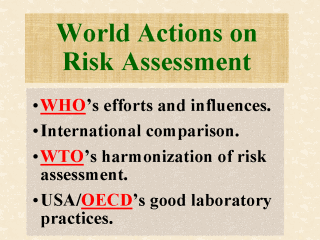| front |1 |2 |3 |4 |5 |6 |7 |8 |9 |10 |11 |12 |13 |14 |15 |16 |17 |18 |19 |20 |21 |22 |23 |24 |25 |review |
 |
World Health
Organization (WHO) has been making great efforts to provide technical guidance for the
conduct of health risk assessments (RA). This is evident from the publication of its
numerous influential technical and health criteria papers related to this subject matter,
such as “Principles for Evaluating Health Risks from Chemicals during Infancy and Early
Childhood”; “Biomarkers and Risk Assessment: Concepts and Principles”; and
“Principles for the Toxicological Assessment of Pesticide Residues in Food.” The International
Agency for Research on Cancer (more commonly known as IARC), that
established by WHO, also provides expert committees to evaluate carcinogenicity of
chemicals based on data available in the literature. A few years back, Moolenaar (1994) had made an international comparison of the methodologies used by several countries for regulatory assessment of cancer risk, partly in response to the international efforts made then to harmonize RA. In addition to the Organization for Economic Cooperation and Development (OECD), other world organizations like the World Trade Organization (WTO) and the United Nations Conference (on the Environment in Rio de Janeiro in 1992) were very active in this harmonization movement. Both USA and OECD have provided regulations and standards governing good laboratory practices (GLP) which cover all phases of toxicity testing, such as animal care, data gathering, laboratory analysis, and sample preparation. GLP are relevant to RA in that the strength-of-evidence and the weight-of-evidence analyses are central to toxicity assessment. |